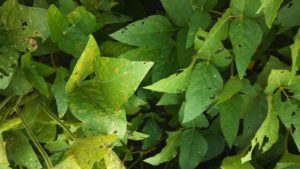Many soybean fields are in reproductive growth stages and need to be scouted for disease to decide if a fungicide is needed. Some diseases that have been observed in fields in Tennessee include frogeye leaf spot, septoria brown spot, and downy mildew.
Based on soybean sentinel plots being monitored in west and middle Tennessee frogeye leaf spot started developing in some fields 2 weeks ago, at very low levels (<1% severity = 1 to 10 leaves out of 50 had one to a few lesions). Frogeye leaf spot lesions are circular to angular leaf lesions with a purple to dark brown margin around a tan to gray center (Image 1). Symptoms usually don’t appear until reproductive growth stages. See previous article on distinguishing disease from chemical injury to make sure chemical injury is not being mistaken for disease. Other diseases noted include septoria brown spot and downy mildew, but neither are usually severity enough to effect yield. To help with foliar diseases identification try the mobile friendly field guide (guide.utcrops.com). Eventually this site will house more information on not only other diseases and crops, but other pest and agronomic information. Kudzu bugs have also been observed in sentinel plots in some southwestern counties in Tennessee. For more information on insect identification and management see article, Some Soybean Insect Pests – Identification and Management on news.utcrops.com by Dr. Scott Stewart.

To better estimate the benefit and yield protection a fungicide application may have use the resources at UTcrops.com to look up information on your variety:
- Disease ratings of varieties – if ‘High’ levels of frogeye leaf spot (FLS) were observed in variety trials the variety has a greater risk for disease development and greater benefit from fungicide application
- Variety yield with and without a fungicide application at R3 (beginning pod) evaluated at different locations that represent different disease pressures. Most dry land fields are most like the low to moderate disease pressure locations (JAX and WTREC locations) and continuous no-till soybean fields under irrigation may be more similar to the severe disease pressure location (RECM).
The variety resources can be found under the soybean disease and nematode page (Yearly Soybean Disease Ratings and Yields – UT Test Summaries) or the soybean varieties page. UT research has previously indicated that under circumstances of high disease pressure and conducive environmental conditions, timing a fungicide application at R3-R5 (beginning pod develop to beginning seed development) often provides the most consistent yield protection on susceptible varieties.
A foliar fungicide efficacy table (Soybean Fungicide Efficacy Table found at UTCrops.com) is developed by The North Central Regional Committee on Soybean Diseases (NCERA-137) and modified as needed by each state to provide information on foliar fungicide efficacy for control of major foliar soybean diseases. The table lists major soybean diseases and rates fungicides efficacy for managing each disease. Additional data on fungicide efficacy and other disease information can be found in the previous article, “Scouting for Soybean Diseases and Deciding on Fungicides.”

